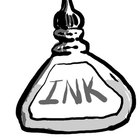
Ordinarily, adding color to frosting is a pretty straightforward business. If you bake regularly, you probably have the basic colors on hand, and it only takes a few drops to achieve the tint you need. One notable exception is black frosting, which is notoriously difficult to produce. Adding conventional colors to your cream cheese icing can eventually produce a medium-dark gray, but the taste of your frosting will suffer. For the best results, use a commercial black coloring instead.
Why Regular Colors Don't Work
Pastel shades are the easiest to achieve with homemade frostings, and the inexpensive liquid food colorings you find at the supermarket are perfectly acceptable for that use. A few drops of the specified color are enough to tint most frostings to a gentle hue, but they're not concentrated enough to easily create rich, saturated colors. Small quantities of vivid-colored icing are available at most supermarkets for adding decorative accents to cakes, but for enough to cover the whole cake, you'd need commercial gel or powdered colors.
Professional-Grade Colors
Professional bakers and pastry chefs use highly concentrated food colorings in powdered or easier-to-mix gel form to create richly colored icing. Most colors are available in small enough sizes for home bakers, either from specialty retailers or online sources. It takes only a tiny quantity of these colorings to produce fully saturated colors, even black. By using less food coloring, you're reducing the likelihood that its distinctive chemical taste will take away from the flavor of your cream cheese frosting.
Darkening the Frosting
Cream cheese icing is nearly pure white, so turning it purely black isn't easy. If the flavor is compatible with your cake, you can make the process much easier by darkening your icing with cocoa or melted dark chocolate. This gives two distinct benefits. First, darkening a brown icing to black requires much less color than making a white icing black. Second, the cocoa or chocolate adds a rich flavor that can help mask the taste of the food coloring. The end result is that your icing will taste and look much better.
Using the Food Colorings
Add either the gel or the powdered color to your icing in very small quantities, either by sprinkling tiny amounts of powder from the tip of a paring knife or by dipping a toothpick in the gel and then stroking it through the frosting. Mix the frosting until the color is well combined, then repeat the process until you're happy with the tint. Black coloring tends to become stronger as it sits, so make your black icing a day ahead whenever possible.
Related Articles

What Food Coloring Combinations Do You ...
How to Make Black Icing

What Colors Do I Mix for Beige Frosting?

How to Make Icing Tulips

What Colors Do I Mix to Get Tan Food ...

When Coloring Frosting How Do I Get ...

How to Add Meringue Powder to ...

What Is Cognac Leather?

How to Lighten Up Burgundy Frosting

Can You Color Boiled Icing?

How to Make Homemade Liquid Rouge

How to Make Pink Frosting Without ...

Can You Use Henna Ink As Eyeliner?

Adding Red Food Coloring to Melted ...

Calories in a Funfetti Cake With ...

How to Make Dark Orange Frosting With ...

What Is Food Coloring Paste?

How to Make Glaze for Donuts With Milk ...

How to Make Silver Ink

How to Add Irish Cream to Buttercream ...
References
Writer Bio
Fred Decker is a trained chef and prolific freelance writer. In previous careers, he sold insurance and mutual funds, and was a longtime retailer. He was educated at Memorial University of Newfoundland and the Northern Alberta Institute of Technology. His articles have appeared on numerous home and garden sites including GoneOutdoors, TheNest and eHow.
Photo Credits
Comstock Images/Stockbyte/Getty Images